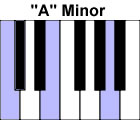Difference Between Major and Minor Chords
Have you ever listened to music and thought that you could detect a sort of personality in the music? Some music sounds upbeat and happy when we hear it. Other music can sound suspenseful, or sad. The ability of music to be calming or unsettling to our ears has to do largely with whether the chords used in the music are major or minor chords. To gain a quick understanding of the difference, play the notes of the C major chord, C, E, and G, on the piano. Play them a couple of times, one note at a time and then all together. Think about how those three notes sound together. Now play the third of the chord a half step lower, making it a minor third. This new, minor chord, uses the notes C, E flat, G. Listen to the difference in the way these three notes sound together. Switch back and forth between the major third and minor third. What differences do you hear? Play a few other major chords, and lower them to minor chords. Begin to develop your ear to hear the difference in these two types of chords.
The main difference in these two types of chords is the quality of the third interval. In music theory, the quality of an interval refers to whether the note falls in line with the key of the root. A note that is found in the key of the root is called the major third. If you lower this note by half a step, you make the third a minor third. If you lower it one more half step, it becomes a diminished third. You can also raise the major third a half step to make it an augmented third. Different combinations of major and minor thirds are used to invoke certain tones within the music. You may be familiar with hearing the minor third used frequently during Halloween season, in music that is meant to sound spooky or creepy. Sad movies use minor thirds peppered throughout the soundtrack to convey sorrow and despair. The major third is used to indicate triumph and happiness, or a sense of calm stability. 
You will find major and minor thirds to be extremely useful, and knowing how to build them and the best context in which to use them should become a priority for the serious piano student. There are several ways that you can practice building major and minor thirds, until they become so habitual that you barely have to put any thought at all into playing them. The first step is to make a chart that shows all of the notes in the chromatic scale: A, A#/Bb, B, C, C#/Db, D, D#/Eb, E, F, F#/Gb, G, G#/Ab. Write these notes in a vertical column on a sheet of paper. Beside the notes, draw three columns and label one minor third and one major third, and the last fifth. Fill in the major and minor thirds in the correct column and the write the fifths to complete each chord. You can use this chart to make flash cards that will help you drill. Write the word major or minor on the back. You can then mix the flash cards and pull out one at a time to play on the piano. Practice telling by the way that the interval sounds whether it is major or minor. Then play the completed chords and see if you can still tell whether the chord is major or minor. You can also make cards to represent each of the notes in the chromatic scale and pull out one at a time randomly. Play the major chord and then the minor chord that is built on that note.
Another way to practice is to develop muscle memory. Try playing ascending major thirds beginning with one note and continuing all the way through the notes of the chromatic scale. Then start over and play minor thirds. Make sure that you use both hands to practice the major and minor chords so that you can play them with either hand when you need to.
With a little practice learning the differences in major and minor chords, you will be able to use them without much thought at all, and put them into your music easily. Begin listening for major and minor chords in the music that you listen to. The more familiar you are with the way they sound, how to build them, and how to play them, the better a piano player you will be.
You can use what you've learned in this lesson along with your piano improvisation skills to quickly figure out what would sound good when you're writing a song on piano. You can also work on your piano transposing ear by playing a note then figuring out if its a major or minor.
<<Back to More Piano Lessons ------ Piano Lesson DVD's >>
